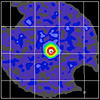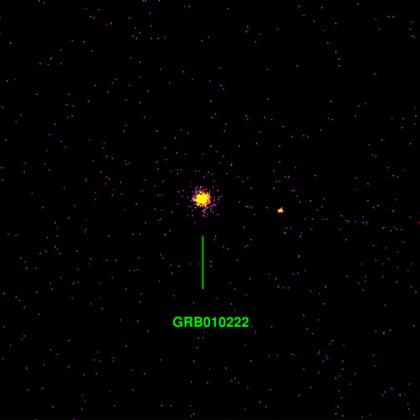Gamma-ray Bursts May Originate in Star-Forming Regions
This Chandra image of the afterglow of a gamma-ray burst, known as GRB010222, provides evidence that these massive explosions take place where stars are born. Several theories exist about what causes gamma-ray bursts including various combinations of merging neutron stars and black holes, or, from the explosion of massive stars, called hypernovae. Using NASA's Chandra X-ray Observatory and the Italian Space Agency's BeppoSAX satellite, Luigi Piro of the Consiglio Nazionale delle Ricerche (CNR) in Rome, Italy, found X-ray evidence that supports the hypernova model.
The data obtained by Piro and his team with Chandra's Advanced CCD Imaging Spectrometer suggest that the blast waves from gamma-ray bursts can hit a wall of very dense gas. According to the researchers, this barrier may be the crowded region where stars form. The hypernova theory of gamma-ray bursts suggest that the massive star required for a gamma-ray burst explosion evolves extremely rapidly – only over the course of about one million years -- within dense star-forming regions. Thus, the hypernova explosion may occur in the same stellar environment that originally produced the massive star itself, and perhaps may trigger even more star formation.
|
||||||||||||||||||||||
This is an image of a gamma-ray burst, GRB 010222 in the sky, with a green line pointing towards the source in the center and labeling its name. The Chandra X-ray Observatory image shows the afterglow of a gamma-ray burst as a mottled, colorful pixelated dot in the center of a large empty black field. The data provides evidence that these massive explosions take place where stars are born, suggesting that the blast waves from gamma-ray bursts can hit a wall of very dense gas. This barrier may be the crowded region where stars form. The hypernova theory of gamma-ray bursts suggests that the massive star required for a gamma-ray burst explosion evolves extremely rapidly – only over the course of about one million years -- within dense star-forming regions. Thus, the hypernova explosion may occur in the same stellar environment that originally produced the massive star itself, and perhaps may trigger even more star formation.





